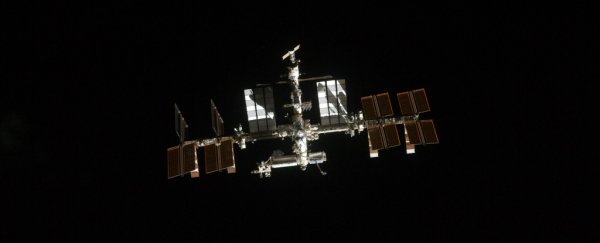It's very early days, but two papers published today have detected hints of elusive dark matter within data collected at the International Space Station (ISS).
Dark matter is the hypothetical substance that makes up 26.8 percent of the known Universe, and explains why our Universe holds together. For decades, scientists have struggled to detect it, and now they might have a new lead - the two separate studies have shown that the number of antiprotons streaming down on the ISS make more sense if dark matter exists.
No one's claiming they've actually detected dark matter here, so don't freak out just yet. But with the hunt for dark matter getting so dire that scientists are now actively looking for ways the Universe makes sense without it, any evidence that validates its existence is a big deal.
Researchers first came up with the concept of dark matter - a mysterious kind of matter that doesn't interact with electromagnetic radiation and therefore is invisible to us - to explain the imbalance between the amount of matter in the Universe and the amount of gravity that holds together our galaxies.
The imbalance lies in the fact that if you add up all the matter in the stars, planets, and cosmic gas within the Universe, it still doesn't explain how we have so much gravity - unless you factor in dark matter.
Despite finding evidence of its hypothesised effects, anything more solid has remained frustratingly elusive. And scientists are now looking for alternative explanations for all the extra gravity in our Universe.
But these latest studies offer up some new hope.
Two separate teams, one from Germany and the other from China and Taiwan, have analysed the amount of antiprotons detected by the Alpha Magnetic Spectrometer (AMS) - an experiment set up on the ISS to count how many antiprotons stream down on the station.
Antiprotons are the antimatter partners of protons, and they make up a small part of the cosmic rays that are constantly streaming through space.
These antiprotons are usually produced through collision between high-energy cosmic rays and interstellar gas (we've been able to create them at the Large Hadron Collider), but they're also predicted to be produced by the hypothetical collision of dark matter - when two dark matter particles annihilate one another.
To get an idea of whether or not this was the case, the two teams independently came up with predictions for how many antiprotons they'd expect the AMS experiment to detect in two scenarios - with or without the presence of dark matter.
The German team found that the data far more accurately matched a model where dark matter annihilation was taking place. More specifically, a model where a dark matter particle existed with a mass of 80 GeV/c2.
The Chinese team used a different set of assumptions but came to the same conclusion - the AMS data made more sense if you assume that dark matter exists. Their model predicted a similar dark matter particle with mass between 40 and 60 GeV/c2.
Most importantly, both teams independently showed that the data better matched models assuming the presence of dark matter than those that assumed dark matter didn't exist.
The fact that two separate teams came up with the same answer is promising, but we're still a long way off confirming dark matter's existence.
However, the research does correspond with a previous dark matter hint discovered using AMS data - an overabundance of positrons, or antimatter electrons, flowing down from space.
Some physicists think these could also be evidence of dark matter, while others think the excess can be explained by other astronomical phenomena, such as pulsars.
Researchers back in 2016 also found a glut of high-energy radiation in the centre of the Milky Way, which some physicists linked to dark matter (although this has been thoroughly debated since).
"That could just be a coincidence," theoretical astrophysicist Dan Hooper from Fermi National Accelerator Laboratory, who wasn't involved in the new studies, told Emily Conover from Science News.
But "it does look pretty encouraging to me for that reason," he added.
The research has been published here and here in Physical Review Letters, and you can also read them here and here on arXiv.org.
